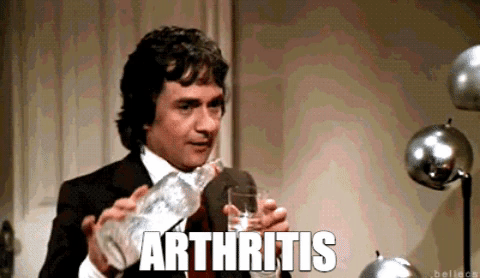In Pursuit of the Holy Grail: Revolutionary Joint Arthritis Therapies

Arthritis is a prevalent and diverse condition that impacts millions of people worldwide. It occurs when the joints, which are the connections between bones, become inflamed, resulting in pain, stiffness, and reduced mobility. Over 100 different types of arthritis have been identified, often associated with other musculoskeletal disorders, each presenting unique characteristics and affecting individuals differently. Osteoarthritis, rheumatoid arthritis, and psoriatic arthritis are the most common types.
In this post, I will explore the current understanding of arthritis, its various therapies, new alternative views on the disease and unconventional treatments. Each section includes medical citations to provide credible sources for further understanding.
It is a close subject to me as i have family members that suffer from Osteoarthritis. Having that in mind, i finished writing a book called Winning At Arthritis, A Guide to Managing Arthritis and Living a Full Life. I am in the process to publish it in 4 languages Here’re the 5 chapters that are covered
- Understanding Musculoskeletal Disorders
- Investigating Metabolic Factors
- Exploring Alternative Therapies
- Nutritional Approaches to Arthritis Management
- Seeking Expertise and Resources
Follow me if you’d like to be updated
Arthritis affects people of all ages and backgrounds, and gaining insights into its causes, symptoms, and treatments is crucial for effective management. Standard therapies, such as medications and physical therapy, alleviate symptoms and improve joint function. However, there is also growing interest in exploring alternative approaches and unconventional treatments that complement conventional care.
What are Musculoskeletal disorders?
Musculoskeletal disorders (MSDs) are a group of medical conditions that affect the bones, joints, muscles, and other tissues of the musculoskeletal system. MSDs can result from hereditary, congenital, or acquired pathologic processes, as well as occupational ergonomic stressors such as repetitive and stereotyped motions, forceful exertions, non-neutral postures, and vibration.
There are many other musculoskeletal disorders that affect individuals that are not included in this list. There can be recurrent pain, stiff joints, swelling, and dull aches associated with MSDs. MSD risk is affected by age, occupation, activity level, lifestyle, and family history. An early diagnosis and treatment may ease symptoms and improve the long-term outlook. These conditions must be identified, treated, and managed.
What are the most common musculoskeletal disorders
Musculoskeletal disorders are caused by a variety of factors, such as age, gender, occupation, and lifestyle, affecting the bones, muscles, joints, and connective tissues of the body. These conditions have a substantial impact on individuals and society. For instance, osteoarthritis, resulting from age-related joint wear, affects millions of people worldwide, leading to pain and reduced mobility. Back pain, often caused by lifestyle and occupational factors, is a common complaint affecting productivity and quality of life. Meanwhile, rheumatoid arthritis, an autoimmune disorder, affects the joints and can lead to joint deformities and disability.
Including specific details and supporting evidence will provide readers with a deeper understanding of the significance of musculoskeletal disorders and their global impact.
- Osteoarthritis (OA): Osteoarthritis is the most common form of arthritis and typically occurs in older adults. It is a degenerative joint disease that primarily affects the cartilage, the protective tissue that covers the ends of bones in a joint. OA can cause pain, stiffness, swelling, and reduced range of motion in the affected joints. Commonly affected joints include the knees, hips, hands, and spine.
- Back Pain: Back pain is a common musculoskeletal disorder that affects people of all ages and can be caused by a variety of factors, including poor posture, muscle strain, injury, and degenerative conditions such as herniated discs and spinal stenosis. Back pain can cause significant discomfort and disability, and is a leading cause of missed work days and reduced quality of life.
- Rheumatoid Arthritis (RA): Rheumatoid arthritis is an autoimmune disease in which the body's immune system mistakenly attacks the joints, leading to inflammation, pain, and joint damage. It can affect multiple joints symmetrically, typically involving the hands, wrists, and feet. RA can also cause systemic symptoms such as fatigue, fever, and weight loss.
- Psoriatic Arthritis: A form of inflammatory arthritis that occurs in individuals with psoriasis, a chronic skin condition characterized by red, scaly patches. Psoriatic arthritis can affect any joint and may cause inflammation in the fingers and toes, leading to sausage-like swelling. In addition to joint involvement, individuals with psoriatic arthritis may also experience skin and nail changes, such as pitting or ridging of the nails.
Carpal tunnel syndrome, tendonitis, muscle/tendon strain, ligament sprain, and fibromyalgia are further frequent musculoskeletal illnesses. Age, sex, career, and way of life are only a few of the variables that can affect these illnesses' prevalence in a population.
Arthritis statistics worldwide (September 2021)
- Global Prevalence: According to the World Health Organization (WHO), arthritis affects around 15% of people globally. It is estimated that nearly 350 million people worldwide have arthritis.
- Osteoarthritis: Osteoarthritis is the most prevalent form of arthritis and is estimated to affect around 10% of men and 18% of women over the age of 60 globally, it affects an estimated 250 million people worldwide.
- Rheumatoid Arthritis: The global prevalence of rheumatoid arthritis is estimated to be about 0.24% of the population, according to a 2020 study in the journal Rheumatology, with women being two to three times more likely to develop the condition than men.
- Disability: Arthritis is a leading cause of disability globally. It is estimated that arthritis-related conditions cause disability in more than 50 million people. It causes pain, stiffness, and reduced joint function, which can lead to significant impairment in quality of life.
- Economic Impact: Arthritis imposes a significant economic burden on healthcare systems and individuals. It leads to substantial healthcare costs, lost productivity, and reduced quality of life.
- Age Factor: Arthritis is more common among adults aged 65 years or older, but people of all ages, including children, can be affected.
- Gender Differences: Women are more likely than men to have arthritis. According to the Centers for Disease Control and Prevention (CDC), about 26% of women and 19.1% of men reported doctor-diagnosed arthritis in the United States.
- Global Initiatives: Several global health organizations, including the World Health Organization (WHO) and the Arthritis Foundation, are actively working to raise awareness about arthritis, improve early diagnosis and treatment, and develop effective management strategies to alleviate its impact on individuals and societies.
What is the associated healthcare cost?
Arthritis is associated with significant healthcare costs, including both direct medical costs and indirect costs such as lost wages. Here are some key findings from available sources:
- In 2013, the national arthritis-attributable medical costs were $140 billion in the United States[5], representing a substantial economic burden on individuals and society.
- For osteoarthritis (OA), the per-person medical costs averaged $11,052 per year between 2008 to 2014, indicating a significant cost associated with OA.
- The total direct medical costs for rheumatoid arthritis (RA) were estimated at $12,509 per year for all RA patients using any treatment regimen, reflecting a significant cost burden for RA.
- Patients with OA incurred significantly higher direct medical costs ($2044) than non-arthritic controls ($1592), highlighting the higher cost burden for individuals with OA.
- The national arthritis-attributable lost wages were $164 billion in 2013, representing a significant indirect cost associated with arthritis.
Globally, the healthcare costs associated with arthritis are also substantial. For instance:
- Osteoarthritis (OA): The average annual cost of OA for an individual is estimated to range between $700 and $15,600 (2019 USD) in different regions worldwide. In the UK alone, estimated costs of hip and knee replacements exceed £850 million.
- Rheumatoid arthritis (RA): The overall cost of RA drugs worldwide was estimated to be $41 billion, with a projected increase to $52 billion by 2018[3]. In the United States, RA directly costs about $19.3 billion per year (in 2005 dollars). Total direct medical costs for all RA patients using any treatment regimen were estimated at $12,509 per year

Causes of Arthritis
The term "arthritis" refers to a wide range of disorders that damage the joints and cause stiffness and discomfort. Depending on the particular form of arthritis, there may be different reasons. Age, heredity, autoimmune responses, joint traumas, infections, metabolic disorders, hormonal changes, and environmental variables are typical contributors. Combinations of these factors frequently have an impact on when arthritis first develops. For those who experience joint pain and stiffness, early diagnosis and adequate management are critical, and accurate diagnosis and therapy depend on getting professional medical guidance. Our knowledge of arthritis and its numerous causes is constantly expanding thanks to ongoing research.
Symptoms of Arthritis
Joint pain, stiffness, and inflammation are the primary signs of arthritis[2][6]. These symptoms may make it more difficult for a person to carry out daily chores and can deteriorate over time. Fatigue, fever, and weight loss are possible additional symptoms.
What is the standard of treatment for arthritis?
The type and severity of the ailment determine the recommended course of treatment for arthritis. Here are a few typical arthritis treatments:
- Pharmacological therapies: Medications such as nonsteroidal anti-inflammatory drugs (NSAIDs), disease-modifying antirheumatic drugs (DMARDs), and biologic agents can help control disease activity, reduce inflammation, and slow down joint damage[1][3][6].
- Physical therapy: Physical therapy can help improve joint mobility, strengthen muscles, and reduce pain. A physical therapist can design a personalized exercise program and teach techniques for managing pain and improving function[1][4].
- Surgery: In severe cases, surgery may be necessary to replace or repair damaged joints[1][3].
- Non-pharmacological therapies: Non-pharmacological therapies such as acupuncture, massage therapy, relaxation therapy, hydrotherapy, and weight management can help alleviate arthritis symptoms and improve overall well-being[1][2][4][5].
- Complementary and alternative medicine (CAM) therapies: CAM therapies such as tai chi, yoga, and herbal supplements may also provide relief for arthritis symptoms[2][4][5].
Citations:
- [1] https://emedicine.medscape.com/article/331715-treatment
- [2] https://www.frontiersin.org/articles/10.3389/fmed.2022.991677/full
- [3] https://www.hopkinsarthritis.org/arthritis-info/rheumatoid-arthritis/ra-treatment/
- [4] https://www.arthritis.org/health-wellness/treatment/complementary-therapies/natural-therapies/8-natural-therapies-for-arthritis-pain
- [5] https://getactv.com/blogs/blog/8-nondrug-treatments-for-arthritis
- [6] https://www.nhs.uk/conditions/rheumatoid-arthritis/treatment
What are the pharmacological therapies?
Pharmacological therapies are medications that can help control disease activity, reduce inflammation, and slow down joint damage in arthritis. Here are some common pharmacological therapies used for arthritis:
- Nonsteroidal anti-inflammatory drugs (NSAIDs): NSAIDs, such as ibuprofen or naproxen, are frequently used as first-line agents for the symptomatic relief of many different inflammatory conditions. They are effective anti-inflammatory and analgesic agents that can help relieve pain, swelling, and stiffness of arthritis and other rheumatic diseases[1][3][6].
- Disease-modifying antirheumatic drugs (DMARDs): DMARDs are a class of medications that can help slow down the progression of joint damage in rheumatoid arthritis. They work by suppressing the immune system and reducing inflammation. Examples of DMARDs include methotrexate, hydroxychloroquine, and sulfasalazine[1][6].
- Biologic agents: Biologic agents are a newer class of medications that can help control inflammation in rheumatoid arthritis. They are genetically engineered proteins that target specific molecules involved in the immune response. Examples of biological agents include tumour necrosis factor (TNF) inhibitors, interleukin inhibitors, and B-cell inhibitors[1][6].
- Corticosteroids: Corticosteroids, such as prednisone, are potent anti-inflammatory agents that can help reduce inflammation and pain in arthritis. They are usually used for short-term treatment of acute flares or as bridge therapy while waiting for DMARDs or biologic agents to take effect[6].
Citations:
- [1] https://www.uptodate.com/contents/disease-modifying-antirheumatic-drugs-dmards-in-rheumatoid-arthritis-beyond-the-basics/print
- [2] https://www.ncbi.nlm.nih.gov/pmc/articles/PMC6422329/
- [3] https://www.ncbi.nlm.nih.gov/pmc/articles/PMC3891482/
- [4] https://www.arthritis.org/health-wellness/detail?content=treatment&filter=ComplementarynTherapies%2Cnaturaltherapies
- [5] https://getactv.com/blogs/blog/8-nondrug-treatments-for-arthritis
- [6] https://www.arthritis.org/health-wellness/treatment/treatment-plan/disease-management/medications-for-arthritis
What are the pharmacological therapeutic contraindications?
Here are some contraindications for pharmacological therapies used for arthritis:
- Nonsteroidal anti-inflammatory drugs (NSAIDs): NSAIDs can cause gastrointestinal bleeding, ulcers, and kidney damage. They should be avoided in patients with a history of gastrointestinal bleeding, ulcers, or kidney disease. NSAIDs should also be used with caution in patients taking blood thinners or with a history of heart disease[1][5].
- Disease-modifying antirheumatic medications (DMARDs): DMARDs have been linked to lung inflammation, liver damage, and bone marrow suppression. Patients with lung disease, blood issues, or liver disease should refrain from taking these. Additionally, patients with a history of infections or malignancies should utilise DMARDs with caution[1][5]..
- Biologic agents: Biologic agents can increase the risk of infections, including tuberculosis and fungal infections. They should be avoided in patients with active infections or a history of recurrent infections. Biologic agents should also be used with caution in patients with a history of cancer or heart failure[1][5].
- Corticosteroids: Corticosteroids have been linked to osteoporosis, weight gain, and high blood pressure. Patients with a history of diabetes, hypertension, or osteoporosis should refrain from taking them. Additionally, patients with a history of infections or psychiatric conditions should utilise corticosteroids with caution.[1][5].
Citations:
- [1] https://www.ncbi.nlm.nih.gov/books/NBK507863/
- [2] https://www.uptodate.com/contents/disease-modifying-antirheumatic-drugs-dmards-in-rheumatoid-arthritis-beyond-the-basics/print
- [3] https://www.ncbi.nlm.nih.gov/pmc/articles/PMC6432894/
- [4] https://emedicine.medscape.com/article/331715-treatment
- [5] https://www.arthritis.org/health-wellness/treatment/treatment-plan/disease-management/understanding-drug-side-effects-and-risks
- [6] https://getactv.com/blogs/blog/8-nondrug-treatments-for-arthritis
What are the non-medication treatments?
Pain management and improved joint function can be achieved using non-drug therapy for arthritis. Here are a few natural remedies that can help with arthritis symptoms::
- Topical Medications: Topical creams, gels, or patches containing ingredients like capsaicin or menthol can provide temporary relief by numbing the area and reducing inflammation[1].
- Physical Therapy: Physical therapy can help improve joint mobility, strengthen muscles, and reduce pain. A physical therapist can design a personalized exercise program and teach techniques for managing pain and improving function[4][6].
- Acupuncture: Acupuncture involves the insertion of thin needles into specific points on the body to stimulate nerves and release natural pain-relieving chemicals. It has been shown to provide relief for some people with arthritis[2][5].
- Massage: Massage therapy can help reduce muscle tension, improve circulation, and alleviate pain. It may be particularly beneficial for individuals with osteoarthritis or fibromyalgia[2][5].
- Weight Management: Maintaining a healthy weight can help reduce stress on the joints, especially in weight-bearing joints like the knees and hips. Losing weight, if necessary, can help alleviate arthritis symptoms and slow down joint damage[5].
- Physical Activity: Regular physical activity, such as walking, swimming, or cycling, can help improve joint flexibility, strengthen muscles, and reduce pain. It is important to choose low-impact activities that are gentle on the joints[6].
- Assistive Devices: The use of assistive devices such as braces, splints, or canes can help support and stabilize the joints, reducing pain and improving mobility[4].
- Heat and Cold Therapy: Applying heat or cold to the affected joints can help reduce pain and inflammation. Heat therapy, such as warm towels or heating pads, can help relax muscles and increase blood flow. Cold therapy, such as ice packs, can numb the area and reduce swelling[1].
Citations:
- [1] https://www.arthritis.org/health-wellness/healthy-living/managing-pain/pain-relief-solutions/fight-arthritis-pain-without-pills
- [2] https://getactv.com/blogs/blog/8-nondrug-treatments-for-arthritis
- [3] https://www.frontiersin.org/articles/10.3389/fmed.2022.991677/full
- [4] https://www.mayoclinic.org/diseases-conditions/arthritis/diagnosis-treatment/drc-20350777
- [5] https://www.arthritis.org/health-wellness/treatment/complementary-therapies/natural-therapies/8-natural-therapies-for-arthritis-pain
- [6] https://www.cdc.gov/arthritis/pain/pain-management-no-meds.htm
What are some of the current limitations of arthritis treatment?
There are several current limitations of arthritis treatment, including:
- No cure: There is currently no known cure for arthritis[1][6]. While treatment can help manage symptoms, it cannot completely eliminate the disease.
- Limited effectiveness of current treatments: Some patients may not respond well to current treatments, such as disease-modifying anti-rheumatic drugs (DMARDs) [2][4]. This can lead to persistent inflammation and joint damage.
- Side effects of treatment: Some treatments for arthritis, such as DMARDs, can have significant side effects, including an increased risk of infections[4].
- Functional limitations: Arthritis can cause functional limitations, such as difficulty performing daily activities and limitations in work and social participation[3][5].
- Limited understanding of the disease: While advances in science are helping us to better understand arthritis, there is still much that is not known about the disease[6]. This can make it difficult to develop effective treatments.
The lack of a cure, the ineffectiveness of present medications, their adverse effects, functional restrictions, and our current understanding of the disease are only a few of the current restrictions on treating arthritis.
Citations:
- [1] https://www.hopkinsmedicine.org/health/conditions-and-diseases/arthritis
- [2] https://www.frontiersin.org/articles/10.3389/fmed.2022.1049875/full
- [3] https://www.cdc.gov/arthritis/data_statistics/disabilities-limitations.htm
- [4] https://reports.glpg.com/annual-report-2015/en/r-d/rheumatoid-arthritis/ra-and-limitations-of-current-treatments.html
- [5] https://www.verywellhealth.com/arthritis-can-cause-functional-limitations-189929
- [6] https://www.hopkinsarthritis.org/arthritis-research/
What are the fringe or innovative therapies to improve arthritis management?
There are several fringe or innovative therapies that are being explored to improve arthritis management. These include:
- Stem cell therapy: Stem cell therapy has become increasingly popular as a therapeutic opportunity for arthritis patients due to mesenchymal stem cells' unique capacity to modulate the immune system[5]. According to a review of several peer-reviewed studies, stem cell therapy has been found to reduce inflammation and improve function in patients with osteoarthritis, rheumatoid arthritis, and other types of arthritis[5].
- Acupuncture: Acupuncture is a complementary therapy that involves the insertion of thin needles into specific points on the body[1]. Some studies have suggested that acupuncture may be effective in reducing pain and improving function in patients with osteoarthritis[1].
- Dietary changes: Some studies have suggested that dietary changes, such as reducing the intake of red meat and increasing the intake of omega-3 fatty acids, may help reduce inflammation and improve symptoms in patients with arthritis[2].
- Cannabis: Cannabis has been found to have anti-inflammatory properties and may be effective in reducing pain and inflammation in patients with arthritis[3]. However, more research is needed to determine its safety and effectiveness.
- Probiotics: Probiotics are live bacteria and yeasts that are beneficial to health[4]. Some studies have suggested that probiotics may help reduce inflammation and improve symptoms in patients with arthritis[4].
Some of the fringe or innovative therapies being explored to improve arthritis management include stem cell therapy, acupuncture, dietary changes, cannabis, and probiotics.
Citations:
- [1] https://www.ncbi.nlm.nih.gov/pmc/articles/PMC3461328/
- [2] https://www.hopkinsmedicine.org/health/conditions-and-diseases/arthritis
- [3] https://www.hopkinsarthritis.org/arthritis-research/
- [4] https://reports.glpg.com/annual-report-2015/en/r-d/rheumatoid-arthritis/ra-and-limitations-of-current-treatments.html
- [5] https://www.dvcstem.com/post/rheumatoid-arthritis
- [6] https://www.frontiersin.org/articles/10.3389/fmed.2022.1049875/full
Are there any other alternative therapies for arthritis management besides stem cell therapy?
Yes, there are several alternative therapies for arthritis management besides stem cell therapy. Some of these alternative therapies include:
- Acupuncture: Acupuncture is a complementary therapy that involves the insertion of thin needles into specific points on the body[5]. Some studies have suggested that acupuncture may be effective in reducing pain and improving function in patients with osteoarthritis[5].
- Platelet-rich plasma (PRP): PRP therapy involves injecting a concentrated solution of a patient's own blood platelets into the affected joint[5]. PRP therapy has been found to reduce inflammation and improve function in patients with osteoarthritis[5].
- Massage therapy: Massage therapy involves the manipulation of soft tissues in the body to reduce pain and improve function[4]. Limited research evidence suggests that massage therapy helps treat joint pain associated with osteoarthritis[4].
- Tai chi and yoga: Tai chi and yoga are low-impact exercises that can help improve flexibility, balance, and strength[5]. Some studies have suggested that tai chi and yoga may be effective in reducing pain and improving function in patients with osteoarthritis[5].
- Dietary changes: Some studies have suggested that dietary changes, such as reducing the intake of red meat and increasing the intake of omega-3 fatty acids, may help reduce inflammation and improve symptoms in patients with arthritis[4].
- Cannabidiol (CBD): CBD is a non-psychoactive compound found in cannabis that has been found to have anti-inflammatory properties and may be effective in reducing pain and inflammation in patients with arthritis[4].
There are several alternative therapies for arthritis management besides stem cell therapy, including acupuncture, platelet-rich plasma therapy, massage therapy, tai chi and yoga, dietary changes, and cannabidiol. While some of these therapies have shown promise in reducing inflammation and improving symptoms, more research is needed to determine their safety and effectiveness.
Thank you for reading this post! If you found it helpful or informative, please consider sharing a 7 day free trial with your friends, family, or colleagues who might benefit from it.
Your support helps me reach more people and spread awareness on important topics like this. Together, we can make a difference!
Citations:
- [1] https://newsnetwork.mayoclinic.org/discussion/mayo-clinic-q-and-a-stem-cell-therapy-for-arthritis/
- [2] https://www.dvcstem.com/post/rheumatoid-arthritis
- [3] https://www.popb.md/2020/03/13/benefits-of-stem-cell-therapy-for-arthritis/
- [4] https://www.arthritis-health.com/blog/5-alternative-treatments-osteoarthritis
- [5] https://www.westsidepainspecialists.com/blog/8-alternative-therapies-for-easing-arthritis-pain
- [6] https://www.hopkinsmedicine.org/health/conditions-and-diseases/arthritis




